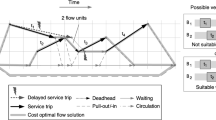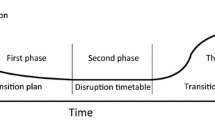Abstract
Local public transport companies, especially in large cities, are facing every day the problem of managing delays and small disruptions. Disruption management is a well-established practice in airlines and railways. However, in local public transport the approaches to these problems have followed a different path, mainly focusing on holding and short-turning strategies not directly associated with the driver scheduling. In this paper we consider the case of the management of urban surface lines of Azienda Trasporti Milanese (ATM) of Milan. The main issues are the service regularity as a measure of the quality of service, and the minimization of the operational costs due to changes in the planned driver scheduling. We propose a simulation-based optimization system to cope with delays and small disruptions that can be effectively used in a real-time environment and takes into account both vehicle and driver scheduling. The proposed approach is tested on real data to prove its actual applicability.



Similar content being viewed by others
References
Abdelghany A, Ekollu G, Narasimhan R, Abdelghany K (2004) A proactive crew recovery decision support tool for commercial airlines during irregular operations. Ann Oper Res 127(1–4):309–331
Barabino B, Di Francesco M, Mozzoni S (2013) Regularity diagnosis by automatic vehicle location raw data. Public Transp 4:187–208
Bartholdi JJ III, Eisenstein DD (2012) A self-coordinating bus route to resist bus bunching. Transp Res B 46:481–491
Berger A, Hoffmann R, Lorenz U, Stiller S (2011) Online railway delay management: hardness, simulation and computation. Simulation 87(7):616–629
Cacchiani V, Huisman D, Kidd M, Kroon L, Toth P, Veelenturf L, Wagenaar J (2014) An overview of recovery models and algorithms for real-time railway rescheduling. Transp Res B 63:15–37
Cadarso L, Marín Á, Maróti G (2013) Recovery of disruptions in rapid transit networks. Transp Res Part E Logist Transp Rev 53:15–33
Carosi S, Malucelli F, Tresoldi E (2015) Delay management in public transportation: service regularity issues and crew re-scheduling. Transp Res Proc 10:483–492
Cats O, Larijani A, Ólafsdóttir Á, Burghout W, Andreasson I, Koutsopoulos H (2012) Bus-holding control strategies: simulation-based evaluation and guidelines for implementation. Transp Res Rec 2274:100–108
Clausen J, Larsen A, Larsen J, Rezanova NJ (2010) Disruption management in the airline industry–concepts, models and methods. Comput Oper Res 37(5):809–821
Daganzo CF (2009) A headway-based approach to eliminate bus bunching: systematic analysis and comparisons. Transp Res Part B Methodol 43(10):913–921
D’Ariano A, Corman F, Pacciarelli D, Pranzo M (2008) Reordering and local rerouting strategies to manage train traffic in real time. Transp Sci 42(4):405–419
De Giovanni L, Heilporn G, Labbé M (2014) A polyhedral study for delay management in public transportation. Proc Soc Behav Sci 108:15–25
Desaulniers G, Desrosiers J, Solomon MM (eds) (2005) Column generation. Springer, Boston, MA, USA
Eberlein XJ, Wilson NHM, Barnhart C, Bernstein D (1998) The real-time deadheading problem in transit operations control. Transp Res B 32(2):77–100
Eberlein XJ, Wilson NHM, Bernstein D (2001) The holding problem with real-time information available. Transp Sci 35(1):1–18
Feillet D, Dejax P, Gendreau M, Gueguen C (2004) An exact algorithm for the elementary shortest path problem with resource constraints: application to some vehicle routing problems. Networks 44:216–229
Glover F, Laguna M (1997) Tabu search. Kluwer Academic Publishers, Norwell, MA, USA
Gualandi S, Malucelli F (2013) Constraint programming-based column generation. Ann Oper Res 204(1):11–32
Hernández D, Muñoz JC, Giesen R, Delgado F (2015) Analysis of real-time control strategies in a corridor with multiple bus services. Transp Res Part B Methodol 78:83–105
Hickman MD (2001) An analytic stochastic model for the transit vehicle holding problem. Transp Sci 35(3):215–237
Huisman D (2007) A column generation approach for the rail crew re-scheduling problem. Eur J Oper Res 180(1):163–173
Huisman D, Wagelmans APM (2006) A solution approach for dynamic vehicle and crew scheduling. Eur J Oper Res 172(2):453–471
Ibarra-Rojas OJ, Delgado F, Giesen R, Muñoz JC (2015) Planning, operation, and control of bus transport systems: a literature review. Transp Res Part B Methodol 77:38–75
Jespersen-Groth J, Potthoff D, Clausen J, Huisman D, Kroon L, Maróti G, Nielsen MN (2009) Disruption management in passenger railway transportation. In: Ahuja RK, Möhring RH, Zaroliagis CD (eds) Robust and Online Large-Scale Optimization. Lecture Notes in Computer Science, vol 5868. Springer, Berlin, Heidelberg
Jin JG, Teo WM, Odoni AR (2015) Optimizing bus bridging services in response to disruptions of urban transit rail networks. Transp Sci 50(3):790–804
Johnson V, Lettovsky L, Nemhauser GL, Pandit R, Querido S (1994) Final report to northwest airlines on the crew recovery problem. Technical report, Technical Report, The Logistic Institute, Georgia Institute of Technology, Atlanta
Kepaptsoglou K, Karlaftis MG (2009) The bus bridging problem in metro operations: conceptual framework, models and algorithms. Public Transp 1(4):275–297
Kiefer A, Kritzinger S, Doerner KF (2016) Disruption management for the viennese public transport provider. Public Transp 8(2):161–183
Lettovskỳ L, Johnson EL, Nemhauser GL (2000) Airline crew recovery. Transp Sci 34(4):337–348
Li J, Mirchandani PB, Borenstein D (2009) A Lagrangian heuristic for the real-time vehicle rescheduling problem. Transp Res E 45(3):419–433
Lougee-Heimer R (2003) The common optimization interface for operations research: promoting open-source software in the operations research community. IBM J Res Dev 47(1):57–66
Malucelli F, Tresoldi E (2018) Delay and disruption management at ATM: technical details. Technical report, Politecnico di Milano-Dipartimento di Elettronica, Informazione e Bioingegneria. http://www.optimization-online.org/DB_HTML/2018/10/6856.html. Accessed 29 Jan 2019
Mároti G (2013) Ultra-short term rescheduling of railway rolling stock. In: Slides at EURO-INFORMS conference
Nissen R, Haase K (2006) Duty-period-based network model for crew rescheduling in european airlines. J Sched 9(3):255–278
Osunaand EE, Newell GE (1972) ontrol strategies for an idealized public transportation system. Transp Sci 6(1):52–72
Potthoff D, Huisman D, Desaulniers G (2010) Column generation with dynamic duty selection for railway crew rescheduling. Transp Sci 44(4):493–505
Raheja AS, Subramaniam V (2002) Reactive recovery of job shop schedules—a review. Int J Adv Manuf Technol 19(10):756–763
Sánchez-Martínez GE, Koutsopoulos HN, Wilson NHM (2016) Real-time holding control for high-frequency transit with dynamics. Transp Res Part B Methodol 83:1–19
Visentini MS, Borenstein D, Li J, Mirchandani PB (2014) Review of real-time vehicle schedule recovery methods in transportation services. J Sched 17(6):541–567
Walker CG, Snowdon JN, Ryan DM (2005) Simultaneous disruption recovery of a train timetable and crew roster in real time. Comput Oper Res 32(8):2077–2094
Wei G, Yu G, Song M (1997) Optimization model and algorithm for crew management during airline irregular operations. J Comb Optim 1(3):305–321
Xuan Y, Argote J, Daganzo CF (2011) Dynamic bus holding strategies for schedule reliability: optimal linear control and performance analysis. Transp Res Part B Methodol 45(10):1831–1845
Yu B, Yang Z, Li S (2012) Real-time partway deadheading strategy based on transit service reliability assessment. Transp Res A 46(8):1265–1279
Acknowledgements
We would like to tank Stefano Gualandi, Fabrizio Ronchi and Stefano Scotti for their contribution that greatly improved the quality and completeness of this paper. MAIOR s.r.l. had a fundamental role in the analysis of the problem and in defining the data retrieval tools. We are gratefully indebted with the reviewers for their constructive comments and helpful suggestions. This work has been awarded the “Best OR application 2016”, by the Italian Association of Operations Research (AIRO).
Author information
Authors and Affiliations
Corresponding author
Additional information
Publisher's Note
Springer Nature remains neutral with regard to jurisdictional claims in published maps and institutional affiliations.
Rights and permissions
About this article
Cite this article
Malucelli, F., Tresoldi, E. Delay and disruption management in local public transportation via real-time vehicle and crew re-scheduling: a case study. Public Transp 11, 1–25 (2019). https://doi.org/10.1007/s12469-019-00196-y
Accepted:
Published:
Issue Date:
DOI: https://doi.org/10.1007/s12469-019-00196-y




